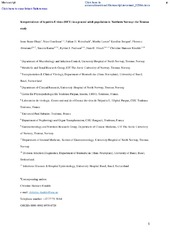Seroprevalence of hepatitis E virus (HEV) in a general adult population in Northern Norway: the Tromsø study
Permanent lenke
https://hdl.handle.net/10037/16653Dato
2019-03-22Type
Journal articleTidsskriftartikkel
Peer reviewed
Forfatter
Olsøy, Irene Beate; Henriksen, Stian; Weissbach, Fabian H.; Larsen, Marthe; Borgen, Karoline; Abravanel, Florence; Kamar, Nassim; Paulssen, Eyvind Jakob; Hirsch, Hans H.; Rinaldo, Christine HanssenSammendrag
Hepatitis E virus (HEV) is a major cause of acute viral hepatitis in many parts of the world but only a few cases have been diagnosed in Norway. To investigate the HEV exposure rate in a presumed low-risk area, we have conducted a population-based study of anti-HEV IgG seroprevalence in Northern Norway. A total of 1800 serum samples from 900 women and 900 men, age 40–79 years, were randomly selected from the 21,083 participants in the 7th Tromsø Study, representing the 32,591 inhabitants of the Tromsø municipality that were ≥ 40 years. All samples were analyzed by ELISA-1 (recomWell HEV IgG). Samples testing positive or borderline, as well as a 1.5-fold excess of negative samples, were retested by ELISA-2 (DiaPro HEV IgG). If still borderline or a result discordant from ELISA-1, the sample was retested by ELISA-3 (Wantai HEV IgG) and strip-immunoassay (recomLine HEV IgG). Anti-HEV IgG was detected in 205 individuals (11.4%), yielding an estimated seroprevalence of 10.4% in the age-matched population of Tromsø. Using logistic regression analysis followed by multivariable backward elimination analysis, increasing age (OR 1.036 per year; p < 0.001) and higher education (OR 2.167; p < 0.001) were found as potential risk factors, whereas travel abroad or eating of red meat were not. Our results indicate that HEV-infection is common in Northern Norway and suggest that HEV testing should be included in the evaluation of elevated liver enzymes.
Beskrivelse
This is a post-peer-review, pre-copyedit version of an article published in Medical Microbiology and Immunology. The final authenticated version is available online at: https://doi.org/10.1007/s00430-019-00599-5.


 English
English norsk
norsk